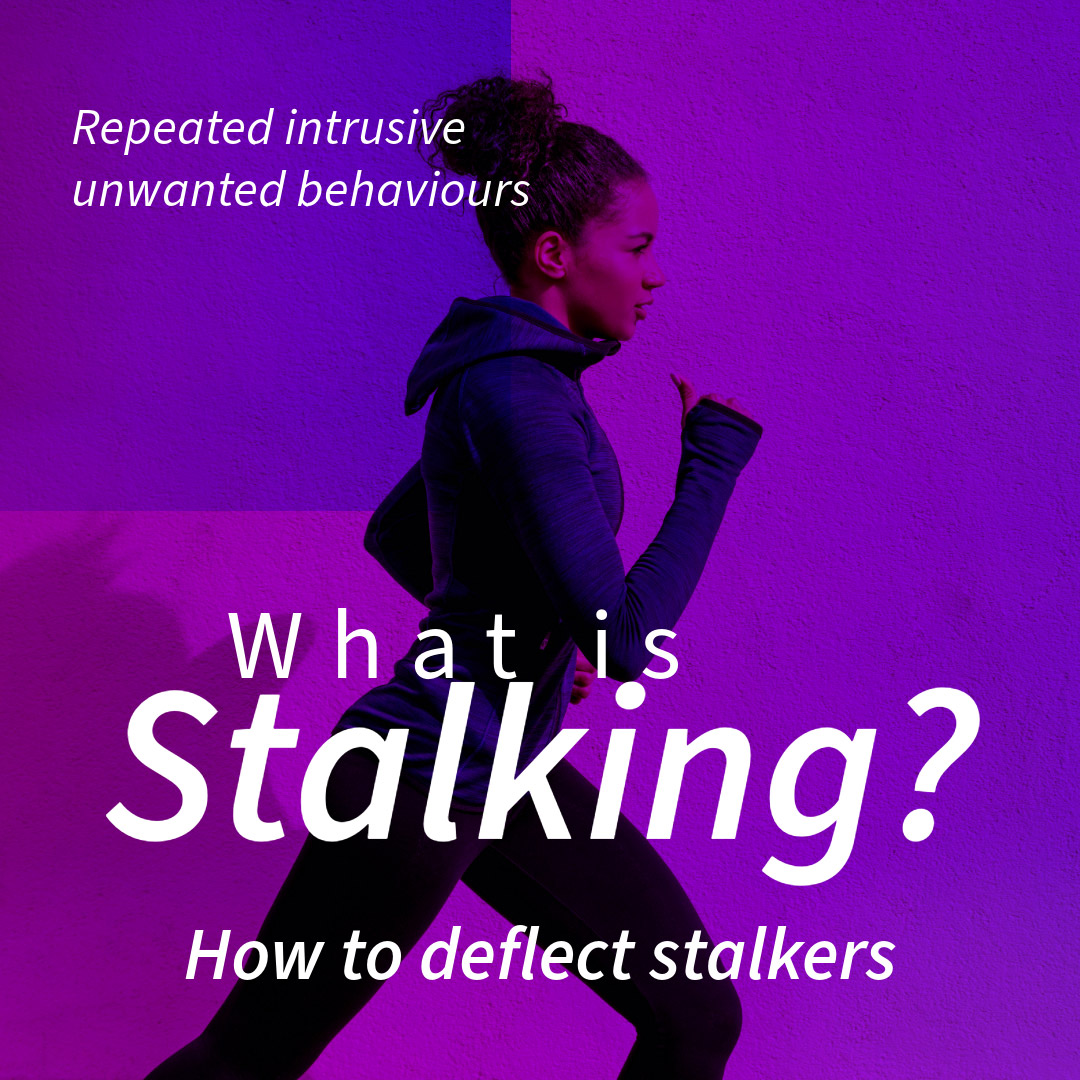Stay Safe, Stay Smart: How To Deflect Stalkers

Ever experienced that unnerving sensation of being watched and followed or the persistent ping of unwanted texts and emails infiltrating your personal space? It's a disconcerting reality that could indicate the presence of a stalker in your life.
In an era where a mere click of a cursor unveils the intricacies of our lives, the concern over potential stalkers gaining access to our personal information looms larger than ever.
Stalkers, ranging from overtly obsessive to covertly insidious, can disrupt your sense of security. In navigating this unsettling landscape, it's crucial to recognize the warning signs and embrace a heightened state of vigilance.

What is stalking?
Stalking is a pattern of repeated, intrusive, and unwanted behaviors that cause fear, anxiety, or emotional distress to the victim. This act involves a persistent and often obsessive pursuit of another person. This creates a sense of vulnerability and violation of personal boundaries.
Here are key characteristics that you need to look out for:
- Unwanted Communication: Stalkers engage in excessive communication attempts, including repeated phone calls, texts, emails, or messages on social platforms.
- Intrusion of Personal Space: This includes showing up uninvited in their home, workplace, or other frequented locations.
- Manipulative Behaviour: Employ manipulative tactics to control or intimidate victims, such as spreading false rumors and attempting to isolate the victims from friends and family.
- Cyberstalking: Due to the popularity of digital communication, stalkers often use online platforms to harass, threaten, and monitor victims.
- Persistent Pursuit: Stalking behavior is persistent and escalates over time. Even when victims express their desire for no contact, the stalker continues their intrusive actions.
Stalking is a serious and potentially dangerous behavior that can have severe psychological, emotional, and physical consequences for the victims. It is essential to recognize the signs of stalking early on, take them seriously, and take proactive measures to ensure personal safety.
Recognising a Stalker
Stalking behaviors often stem from complex psychological factors, and recognizing these red flags can help identify potential stalkers. It's important to note that while certain traits may be indicative, a combination of behaviors and the context in which they occur is more telling.
1 Obsessive Fixations: Fixation on specific individuals due to feelings of rejection, inadequacy, or a distorted sense of attachment. This fixation often becomes the driving force behind stalking behavior.
2 Low Empathy and Lack of Remorse: These individuals lack the capacity for empathy, making it challenging for them to comprehend the distress they cause. This could be linked to underlying personality disorders or emotional dysregulation.
3 Paranoid Beliefs: Interpret capacity for empathy, making it challenging for them to comprehend the distress they cause. This could be linked to underlying personality disorders or emotional dysregulation.
4 Narcissistic Traits: Pursuing control and dominance over others may be driven by a fragile self-esteem or a need to compensate for perceived deficiencies.
5 Lack of Boundaries: Disregard for personal boundaries, both physical and emotional.
It's crucial to stay watchful if someone around you is showing these warning signs. Being alert helps you notice subtle signals and potential dangers. When you recognize these behaviors, staying vigilant is like having a protective shield, allowing you to respond wisely and keep yourself safe.
Can this be considered stalking?
Let's say you are being bombarded with texts and calls from someone claiming it's their "job" to do so. Once or twice, we have received unwanted calls and texts from real estate or call centre agents, and you have no idea how they got your number.
You never asked for these messages; even after telling them to stop, they keep coming. Is this considered stalking?
It can be considered persistent and unwanted communication, which might be a form of harassment. In the context of real estate transactions, aggressive or excessive communication from a broker could cross ethical boundaries, leading to discomfort for the recipient. While it may not meet the legal criteria for stalking, it could be considered an invasion of privacy or a violation of professional conduct.
Taking safety measures
Securing your physical and digital space from a potential stalker involves a combination of proactive measures and technological precautions. Here's a comprehensive guide:
1 Strengthening Physical Security
a. Change locks: If you suspect someone may have access to your home, change locks immediately.
b. Install security system: Consider installing security cameras and alarms to monitor and protect your residence.
c. Vary your routine: Avoid predictable patterns in your daily activities and routes.
d. Secure windows and doors: Reinforce doors and windows with sturdy locks and install additional security measures such as window bars.
2 Boosting Digital Security
a. Update privacy settings: Regularly review and update privacy settings on social media platforms. Limit information visible to the public and adjust settings to control who can access your profile.
b. Monitor online presence: Regularly check your online presence for unauthorized accounts or information. Report and remove content that poses a security risk.
c. Limit information put online: While social media and the online world are a great way to communicate, ensure your private details such as home addresses, contact numbers, and bank accounts are hidden.
3 Personal Safety Measures
a. Self-defense training: Consider taking classes to equip yourself with basic techniques and strategies.
b. Emergency contacts: List available emergency contacts and program them in your phone.
c. Safety apps: Explore safety apps that allow you to share your location in real time with trusted contacts. Some apps also have panic buttons that can alert authorities in an emergency.
d. Carry a personal alarm: A small, easily accessible one can attract attention and deter potential threats.
Combining these physical and digital security measures can create a robust defense against potential stalking threats. Contact local law enforcement for assistance if you ever feel in immediate danger.
Personal legal measures
Being proactive is key to staying safe from stalking. It's not just about preventing it but also taking legal steps ahead of time for added protection. Here's an elaboration on the legal steps one can take:
1Obtain a restraining order
A restraining order, also known as a protection order or order of protection, is a legal document issued by a court that restricts the alleged stalker from approaching or contacting the victim. Visit your local courthouse to file a petition for a restraining order Provide evidence and a detailed account of the stalking incident.
2Documenting evidence
Maintain a thorough record of stalking incidents, including dates, times, locations, and descriptions. Save any relevant messages, emails, or gifts. Proper documentation is valuable evidence in legal proceedings and strengthens the case against the stalker.
3Staying informed about laws
Stay informed about stalking laws in your jurisdiction. Laws may vary, and understanding your rights and legal options is crucial. Utilize legal resources, such as local victim assistance programs or legal aid services, to navigate the legal landscape effectively.
Remember, seeking legal advice from professionals experienced in handling stalking cases is essential. They can guide you through the specific legal processes in your jurisdiction and help tailor the legal response to your unique situation.
Final takeaways
Being vigilant and proactive in addressing stalking is essential for personal safety. By recognizing the signs, implementing preventive measures, and taking legal steps when necessary, individuals empower themselves to navigate the challenges of stalking with resilience and confidence. Remember, your safety is a priority; taking decisive action can significantly protect yourself from potential harm.
SEARCH ARTICLES
advanced search tips examples: "Yoga Meditation" Therap* +Yoga +MeditationRecent Posts

Nov 27 2025
The Psychology Behind the Primacy Effect

Jun 24 2025
Microplastic Exposure: Bottled Water vs Tap

Jun 09 2025
Squats for aligning hips

Apr 29 2025
Creative Thinking

Jan 28 2025
How to talk to someone you disagree with

Jan 27 2025
Alcohol Causes Cancer

Jan 14 2025
The role of the Amygdala

Oct 04 2024
A Support Guide for Anorexia Nervosa

Jun 25 2024
Sleep better



